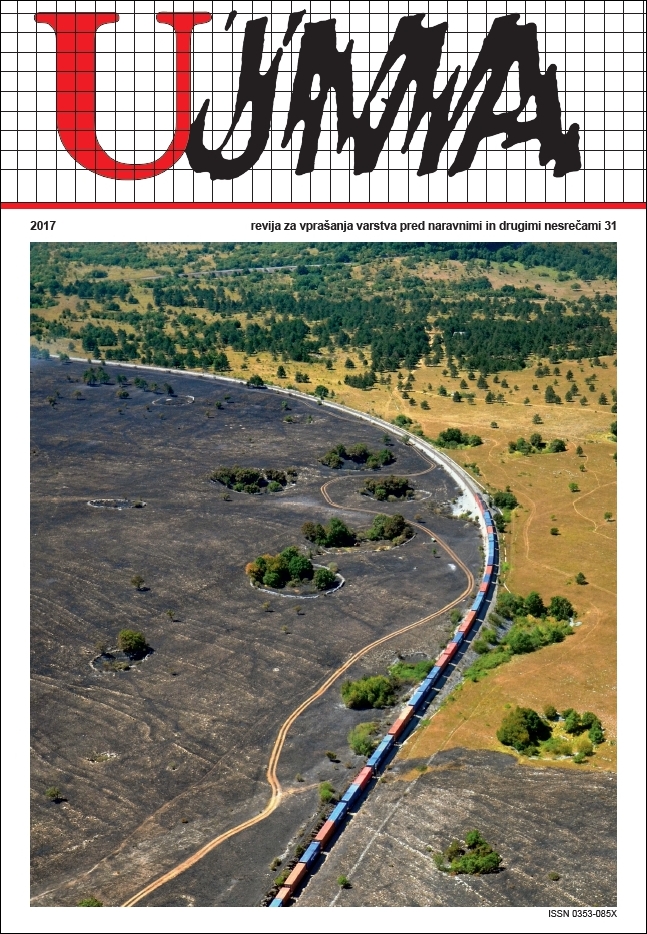NEW APPROACHES TO DROUGHT MONITORING IN THE DANUBE REGION – THE INTERNATIONAL DRIDANUBE PROJECT
Abstract
The frequency and duration of drought events in the Danube region (including Slovenia) has increased in past decades. Additionally, drought events have had increasing negative impacts on both the economy and the welfare of the people. In order to improve the resilience of society to drought events we have successfully submitted a proposal for an international project aiming to manage drought-related risks, called Drought Risk in the Danube region – DriDanube. Work on the project started at the beginning of 2017. The main objectives of the project are 1) improving drought monitoring in the region by developing an innovative Drought User Service using modern “Big Data” management techniques, which will enable more accurate and efficient early warning of drought; 2) improving and harmonizing currently heterogeneous methodologies for risk and impact assessments in participating countries, by providing cross-border comparable methodology based on EU guidelines within the framework of the Civil Protection Mechanism; and 3) preparing a DriDanube Strategy for a proactive response to drought events and for strengthened cooperation between all the relevant institutions. The project connects 23 partners from 10 countries in the Danube region (including universities, research institutes and national meteorological services). The partners from Slovenia participating in the DriDanube project are the Administration for Civil Protection and Disaster Relief, the Slovenian Centre of Excellence for Space Science and Technologies (SPACE-SI), and the Slovenian Environmental Agency, which is also leading the project.
References
Carpatclim, 2017. Climate of the Carpathian Region. http://www.carpatclim-eu.org/pages/home/.
DMCSEE, 2017. Drought Management Centre for Southeastern Europe. http://www.dmcsee.org/.
DriDanube, 2017. DriDanube – Drought risk in the Danube region. http://www.interreg-danube.eu/approved-projects/dridanube.
DTP, 2017. Danube Transnational Programe. http://www.interreg-danube.eu/.
EODC, 2017. Earth Observation Data Centre for Water Resources Monitoring. https://www.eodc.eu/.
European Commission, 2017a. European civil protection and humanitarian aid operations. http://ec.europa.eu/echo/what/civil-protection/mechanism_en.
European Commission, 2017b. EU Civil Protection Mechanism. http://ec.europa.eu/echo/what /civil-protection/mechanism_en.
European Commission, 2017c. A Water Blueprint – taking stock, moving forward. http://ec.europa.eu/ environment/water/blueprint/index_en.htm
European Commission, 2017č. The EU Water Framework Directive – integrated river basin management for Europe. http://ec.europa.eu/environment/water/water-framework/index_en.html
GWPCEE, 2015. Guidelines for the preparation of Drought Management Plans. Development and implementation in the context of the EU Water Framework Directive, 48 str.
IDMP, 2017. Integrated Drought Management Programe. http://www.droughtmanagement.info/
Intersucho, 2017. Projekt Intersucho, ChechGlobe, Global Change Research Institute of the Czech Academy of Sciences. http://www.intersucho.cz/en/
Kajfež Bogataj, L., 2012. Prilagajanje podnebnim spremembam. Ujma, 26, 195–201.
Orientgate, 2017. Orientgate project. http://www.orientgateproject.org/index.php? page=national-institute-of-meteorology-and-hydrology-bg
Sušnik, A., Valher, A., 2013. Neugodni vplivi vremena na kmetijstvo leta 2012. Ujma, 27, 62–70.
Sušnik, A., Valher, A., 2014. Od mokre pomladi do sušnega poletja 2013. Ujma, 28, 75–84.
Sušnik, A., Valher, A., 2016. Vpliv poletne vročine, suše, mokre jeseni in mile zime na vegetacijo leta 2015. Ujma, 30, 69–77.
Downloads
Published
Issue
Section
License

This work is licensed under a Creative Commons Attribution-NonCommercial-NoDerivatives 4.0 International License.
The articles are made available to the public under Creative Commons Attribution-NonCommercial-NoDerivatives 4.0 International (CC BY-NC-ND 4.0).


